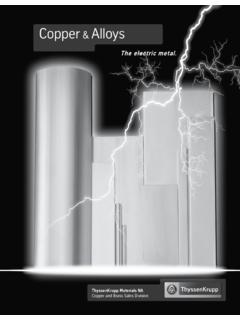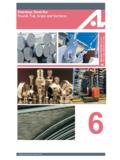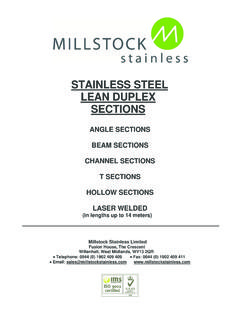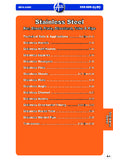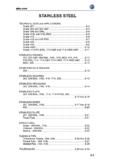Transcription of Stainless Steel - ThyssenKrupp
1 For more information call (800) 926 -2600 1. Materials Services Copper and Brass Sales Stainless Steel Service You Can Count On. At ThyssenKrupp Materials NA, Copper and Brass Sales, we're committed to being your best source for Stainless Steel . We maintain a large, diversified inventory to ensure quick delivery from any one of our North American locations, and offer superior precision processing so your order arrives in immediately usable condition. Because of our extensive inventory and excellent service, we currently supply Stainless Steel to customers in a vast array of industries such as automotive, construction, food processing, chemical processing, aerospace, medical, oil and gas, and more.
2 Our sales representatives are always pleased to help you and furnish technical assistance to resolve your special application problems. Contact us today to learn how we can satisfy all of your Stainless Steel requirements. For more information call (800) 926 -2600 2. C. ontent 3 Introduction 33 Premium Machining Rod & Bar 3 Introduction to Stainless Steel 33 Screw Machine Products 3 Stainless Steel Defined 33 MAXX Stainless Steel 3 Austenitic Family 34 Project 70+ . 3 Ferritic Family 3 Martensitic Family 4 Precipitation Hardening Family 36. 4 Stainless Steel Type Designations 5 Stainless Steel Alloy Descriptions 6 Stainless Steel Equivalent Designations Sheet & Plate 36 Sheet Finishes 37 Sheet 7 38 Plate Long Products 39.
3 7 Material Properties 7 Physical Properties 7 Mechanical Properties Estimating Formulas 8 Chemical Compositions 8 Type 17-4, Mechanical Properties 39 Weight Formulas 9 Mechanical Properties of Precipitation Hardening Types 40 Weight of Stainless Steel Bars 10 Machining Data 41 Hardness Conversions 10 General Machining Guidelines 10 Fabrication Properties 11 Machinability Ratings 12 Machining Speeds and Feeds 13 Stainless Steel Bar Finishes 14 Stock Availability 14 Round Bar 24 Square Bar 25 Rectangular Bar 28 Plating Rack Stock 28 Rectangular Strip 29 Hexagon Bar 32 Equal Angle Note.
4 The data contained within this brochure has been compiled and developed from many sources. While every effort has been made to cross-check and verify this information, ThyssenKrupp Materials NA, Inc., does not guarantee its accuracy. This data is not to be used for design or specification purposes. Copyright 2017 ThyssenKrupp Materials NA, Inc. 3 . Introduction to Stainless Steel Stainless Steel Defined Austenitic Summary: Hardenable by cold working Stainless Steel came into being in the early 20th Century because of Medium to high strength an urgent need for bette r materials.
5 Chemical processing, oil Non-magnetic refining, and other new manufacturing activities of the time were High resistance to corrosion quickly surpassing the performance barriers imposed by Contains nickel conventional engineering materials. It was an English metallurgist, Harry Brearley, who discovered Ferritic Family Stainless Steel while searching for an improved alloy to protect cannon bores. He found that by adding chromium to low carbon Ferritic Stainless steels are iron-chromium alloys which cannot Steel , the Steel became stain resistant. Further research showed that be hardened significantly by heat treatment.
6 The protection mechanism that inhibited this rust was the formation of a microscopically-tight, self-healing, protective-oxide film on the The ferritic types are intermediate in their ability to withstand surface of the metal. corrosion. Increasing the amount of chromium raises the corrosion resistance of the metal. A chromium content of This film has proven resistant to corrosives such as water, air, foods, about 10% is necessary to ensure maximum corrosion and alkalis. The oxide is so thin and transparent that it escapes resistance. Additional amounts of chromium (up to about detection by the unaided eye.)
7 When scratched, nicked, or otherwise 20%) are utilized to further increase the resistance of the penetrated, a fresh film forms almost instantly on the exposed metal to oxidation and scaling at elevated temperatures. portion of the metal. Ferritic types are highly resistant to atmospheric oxidation and Stainless Steel is defined today as a Steel alloy containing at least strong oxidizing solutions. Qualities include adaptability to 10% chromium, plus other elements especially nickel. Generally high-temperature, chemical, and outdoor use. speaking, Stainless Steel may be subdivided into four basic families: Ferritic Stainless steels are magnetic in all conditions.
8 Austenitic Family Ferritic Summary: Not hardenable by heat treatment or cold working Austenitic Stainless steels are iron-chromium-nickel alloys which are Moderate strength hardenable only by cold working. Nickel is the main element varied Magnetic within the alloys of this class while carbon is kept to low levels. The Low resistance to corrosion nickel content may be varied from about 4% to 22% higher values Does not contain nickel of nickel are added to increase the ductility of the metal. When chromium is increased to raise the corrosion resistance of the metal, nickel must also be increased to maintain the austenitic structure.
9 Martensitic Family These alloys are slightly magnetic in the cold-worked condition, but Martensitic Stainless steels are iron-chromium alloys that are essentially non-magnetic in the annealed condition in which they contain from 10% to 18% chromium and can be hardened by are most often used. heat treatment to high strength levels. Type 410 Stainless Steel is the basic alloy in this grouping. The martensitic types are The austenitic types feature adaptability to cold forming, ease of the lowest in their ability to withstand corrosion. welding, high-temperature service, and, in general, the highest corrosion resistance.
10 Adding more carbon to the basic martensitic alloy increases hardness. But, as carbon is increased, chromium content is also increased to as high as 18% to maintain no less than 10%. free chromium for corrosion resistance. For more information call (800) 926 -2600 4. Precipitation Hardening Family Other modified martensitic alloys contain additional elements, such as sulfur or selenium. This group of iron-chromium-nickel alloys has a corrosion resistance approaching that of the austenitic types and can be Martensitic varieties find major applications in products that heat treated to high strength levels approaching that of the must resist atmospheric oxidation, mildly corrosive chemicals, hardenable martensitic types through a special heat-treating and wet or dry corrosion environments found in steam and cycle.
